江上越伦敦个展"对话400年"开幕 --千叶成夫,近藤成一学术主持 Antonia Huber,Julia von Meiss策展
市长的贺电
江上越 女士
衷心祝贺江上越个展《对话400年》在伦敦开幕。
江上越女士的作品给予人们感动,我真诚期待江上越女士作为日本和世界的桥梁的艺术家取得更高的成就!
千叶市长 熊谷俊人
2018年2月16日
Dear Ms. Etsu Egami
I sincerely cerebrate the holding of "Dialogue beyond 400 years - Etsu Egami solo exhibition"
I hope that Ms.Etsu Egami's works will inspiring people as the artist who become the bridge between Japan and the world .
Mayor of Chiba city Toshihito Kumagai
江上越的"误听游戏"――一种感觉和另一种感觉
千叶成夫 美术评论家
江上越尝试的"语音"作品,准确地讲不是"误解"而是"误听"的问题。当然"误听"会导致"误解",日常习惯或者是语义的扩展,说成是"误解"也没什么关系。但如果这样就感觉有些走味了。说到"误解",例如像Albert Camus的著名戏剧作品《误解(Le Malentendu)》往往感觉很深刻。而日常生活中,用同音异义词调侃,还能给会话增添不少精彩。例如日语中 "误解"的发音,也可以听成是"五阶"、"碁会"、" ゴカイ"、"五戒"等等。
值得注意的是,江上越本人用了"mis-hearing",而不是"mis-understanding"也不是
" mis-apprehension"。就是说,她是把感觉(这里是听觉)层面的错位作为创作的切入点。人通常说"五感",除此以外应该还有两种,一个是比"触感"范围更广的"身体感觉",一个是广义的通过想像产生的所谓"想象感觉"(包含预感、妄想等等)。理所当然,这里的"感觉"并不是指到达大脑的生理刺激,而是大脑综合判断的行为,实际上是指形成的"认识"。
还有,即使人只使用听觉,其实,其他的感觉也不是在睡大觉。例如闭着眼睛听音乐的时候,听觉(除了视觉)和其他所有的感觉一起在共感。画画的时候也是,视觉和其他所有的感觉一起都在起作用。人的"感觉"或多或少是综合性的产物。好像人的大脑天生就是这样的。而且,不要忘记江上越首先是一个画家,或者说也是一个画家。
可以说江上越"语言游戏"的尝试至少和视觉是连动的。她的几乎所有的"误听游戏"作品,或者说常常是充满了想象,伴随这种装置的展示是有理由的。她好像是在强调通过听觉产生"误听",但又不尽然。因为产生(错误=误动作)一个感觉会波及人的所有感觉。
江上越创作"误听游戏"作品的契机是来自她在北京留学时的个人体验。尽管日本和中国同是使用汉字,但到了21世纪的现在,同一个汉字同一个单词,如果单从发音来判断,就很难知道双方的本义了,这里产生的误解和龃龉触发了她的创作灵感。如果仅仅是这样,也只是语意上的误解和龃龉问题罢了。汉字是象形文字,对一个一个的汉字在不同的历史时期不同的地域产生了多种不同的读音。传出中国本土改变了读音也是理所当然的事。
这里产生的"误解"问题,今后也解决不了吧,还会继续酝酿出各种悲喜剧。同时,谋求解决和缓和的努力也会继续下去吧。但是,世界语也好英语也好都不可能征服世界,也不需要这样的世界。土地、水、风土、空气的差异必然导致人的差异、语言的差异。这是有理由的,必然的,自然的,多样性好。
作为美术家的江上越,马上意识到这一点,从"语言的误解和龃龉"的课题把问题放大,向着更根本的方向延展她的探索。
其中一个方向,就是国家和地域的差异,也就是浮现出来的文明?文化的差异。也可以说她是在主动地认识"误听"所产生的多样性。既然"误听"不可避免,她就试图如何捕捉其中更多的正面能量。
随便提一句,她的绘画作品"人颜"系列,就是尝试将这种想法放进视觉艺术中去。人的脸不断地产生细微的变化,这就是所谓的"表情"。出入海关时,海关人员要用自己的眼睛核对护照上的照片和眼前的本人,因为即使是完全如实地记录对象的相机,也很难捕捉尽表情的细微变化。照片只能抓住一个瞬间,而绘画却能表现出表情的多样性。江上越的绘画好像是夸张了对象的特征和表情,其实不然,她是把一张画面捕捉不尽的表情综合地画进去。对应于"误听"她是把"误视"作为褶裥编织入内,刻画进作品。所以,从本质上讲她是用了与"误听游戏"同样的方法,但表现的却是绘画作品。
还有一个我认为有可能的方向,就是尝试把"听觉"和"视觉"绑在一起(或连动、或并置、或背道而驰)表现同样的主题。也许是梦想,我仍然期待着。
Etsu Egami's "Mis-hearing Game" - One Sensation and Another Sensation
Shigeo Chiba (Japanese Art Critics)
To be accurate, what Etsu Egami is trying in her work of "words (language)" is not a "misunderstanding" but a problem of "mis-hearing". Of course, "mis-hearing" can be the source of "misunderstanding", so it can be said that it doesn't matter if you expand it to "misunderstanding" in general, but then it seems that the story will be slightly misguided. "Misunderstanding", for example, could be serious understood as a prominent drama work "Le Malentendu" by Albert Camus. But it is common to add coloring to a conversation in everyday life, using homonyms sometimes with puns. For example, if you pronounce the word "misunderstanding" in Japanese only by sound,"Five Levels", "Go Session", "Gokai (Roswell)," "Five Commandments" can be the same sound either.
It should be noted that Etsu Egami herself uses the word "mis-hearing" rather than "mis-understanding" or "mis-apprehension". In other words, she has a theme of "mistakes" at the level of sense (hearing at now). People's sense is usually said to be "five senses". However, it is obvious that there are at least two other things, "body sensation" which is more extensive than "tactile" and a feeling arising from imagination in a broad sense, so to speak and "imagination feeling" (such as premonition or delusion) I think that should be added I think. Also of course, here also, "sensation" is not a physical stimulation up to the stage where it reaches the brain, but it It refers to becomes a (total) judgment by the brain and it becomes behavior, that is, "recognition" what it is.
And, for example, do not forget the fact that other feelings are not asleep while one hears. Even if I close my eyes and listen to music, other senses except vision are also working. So hearing is working with all senses (except vision). Even when drawing a picture, vision works with all other senses. Human "sense" is always more or less comprehensive. Apparently, the human brain seems to be made like that. Besides, do not forget that Etsu Egami is a painter first, or is also a painter.
In other words, Etsu Egami's "Mis-hearing of words" should be linked with at least vision. There is a reason why her "mis-hearing games" work is an exhibit , mostly or often image wise, or with such installations. It also sometimes emphasizes "Mis-hearing" that occurs in the sense of hearing, but that is not all. "Mistake = malfunction" that occurs in one sense exerts its effect on the whole human sense.
The inspirations for Etsu Egami's "mis-heariing game" works comes from her personal experiences when she was studying in Beijing. Japan and China share the same kanji, but at the present in the 21st century, even if the same kanji or the same word is pronounced as "sound", there are circumstances in which both sides do not have the same meaning. She was inspired by the misunderstandings and discrepancies of that. But only that, it is only a misunderstanding of the meaning of words and a matter of discrepancies. Hieroglyphics called kanji form a lot of different readings historically and locally for each character (kanji), and it is of course that once you leave the mainland of China its reading will be changed.
The problem of "misunderstanding" that came from there will not be solved in the future, it will continue to produce tragicomical stories. Conversely, efforts to solve or mitigate will also continue. However, Esperanto and English cannot conquer the world, and I want to say sorry to such a world. If land, water, culture and air are different, naturally humans and their languages are different. There is a reason ,necessity and nature in that, diversity is a good thing.
As an artist, she immediately noticed that. And from the level of "the misunderstanding and discrepancy of the meaning of the words", She is trying to extend the problem to a bigger, more fundamental direction.
One of them is the direction of bringing out differences between countries and regions, that is, differences in civilization and culture. It can be said that it is a direction to positively recognize the diversity that "mis-hearing" occurs. Since "mis-hearing" is inevitable, it is a way of thinking that it is positive.
By the way, her painting work depicting "human face" can be said to be an attempt to bring that idea visually. People 's face are changing constantly and constantly. That is what is said to be an "expression". The immigration officer has to compare the face photograph on a passport with the face of the person in front of the his eyes, even with a machine that proposes to reflect reality as it is like a photograph. It is because they can't catch the delicate changing of facial expression of a person. Photographs can only catch a little moment, but paintings can describe the diversity of human facial expressions. It may seem that Etsu Egami's painting exaggerates features and expressions, but it is not. She was trying to draw the face of a person who can not be caught in one shot as comprehensively as possible. It is a work drawn by incorporating "mis-seeing" corresponding to "mis-hearing" as a fold. So basically it stands in the same way as a "mis-hearing game", but it is a painting work.
Another direction that I think might be possible , would be the direction to try the same thing with a work that combines "auditory" with "visual" (linked, juxtaposed, dressed) . It may be a dream, but I am thinking about that. ■
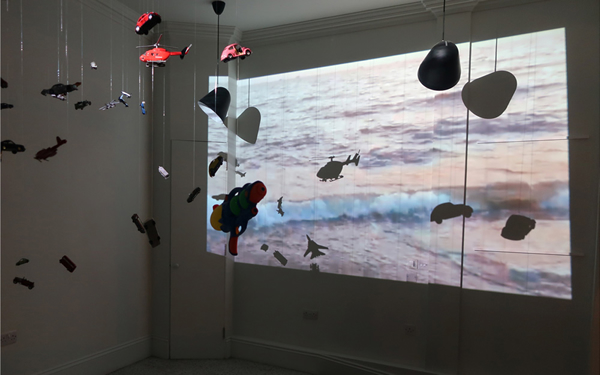
江上越作品《Dialogue beyond 400 years》作品现场-1
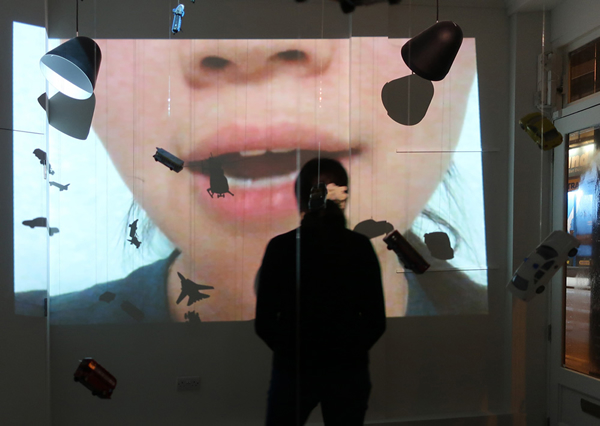
江上越作品《Dialogue beyond 400 years》作品现场-2
近藤成一 历史学家
东京大学名誉教授
放送大学教授
千叶市艺术文化新人奖评委主席
欧亚大陆的中部,汽车和列车都是走右侧。被大海遥遥相隔的东方日本和西方英国却是左侧通行,因为日本的近代交通体系是效仿英国的。英国的交通体系与欧洲大陆不同,是因为大海的隔离,而英国的交通体系传到日本却又是大海的沟通。
1600年,英国人威廉亚当斯(William Adams, 1564-1620)作为航海士,上了荷兰的商船De Liefde号,漂流到日本,他应该是第一个来到日本的英国人。他得到了统治日本260余年的德川家的重用,后半生在日本度过,参与了在日本开设英国商馆,后来死在日本。
1980年,美国NBC以威廉亚当斯为原型拍摄了电视剧"Shōgun",剧中的主人翁最初不懂日语,觉得日本的事情远远超出他的理解。后来渐渐习惯语言,才理解日本。这个电视剧也是通过这个过程让不懂日语的视听者体验当时的情景。
江上越的作品中,背景通过投射海的映像, 探索人类交流的可能性。作品中的海是江上的故乡千叶的海。最近,江上获得了千叶市艺术文化新人奖,授奖仪式上千叶市长赞叹江上的作品着眼于千叶的海域,并强调千叶的东南西三方都是被大海环绕。事实上,这个地域与其他地域的交流,海上交通起到了很重要的作用。
江上的创作主题中"误认"是一个重要部分。交流的最初,误认是无法避免的。或者说,认识"误认"也许是达到正确认识的唯一途径。江上提示的"误认"应该说是这种意义上的误认吧。但也许,是我误认了江上的创作意图。尽管如此,我还是想基于这个认识来鉴赏江上的作品。
What the sea plunges, things that connect
Prof. Dr. Shigekazu Kondo
Emeritus Professor University of Tokyo
Chiba City Arts and Culture New Award Selection Committee Chairperson
Professor of The Open University of Japan
In the middle of the Eurasian continent, both cars and trains run on the right side, but Japan and the UK , which are floating across the sea over the east and west side of the continent ,are driving on the left side. Traffic on the left side in Japan was due to upgrade the modern transportation system following to the UK. It seems that the sea, which separated the transportation system between the UK and the continent , made them different, but it was also the sea that conveyed the British transportation system to Japan.
In 1600, the British William Adams (1564-1620) had gotten on to the Dutch merchant ship Releafde (De Liefde) as a navigator, but as the ship was drifting in Japan, he became the first British who landed in Japan . Adams was heavily used in the Tokugawa family who will dominate Japan for just over 260 years from that year. He spent the rest of his life in Japan, where he was involved in opening a British trading house in Japan, and died in Japan.
The TV drama "Shōgun" produced by the American / NBC in the 1980s used Adams as a model. For the hero who could not speak Japanese at first, the mentality of Japan were beyond his understanding at all, but gradually he became accustomed to the Japanese life and learned to understand the mindset of Japan. This drama is made to let the English speaking audience pursue the process.
In Etsu Egami's work, there is some her work that reflects the sea and questions the possibility of communication. It is said that the mentioned sea is Chiba's sea which is the hometown of Egami. Egami recently won the Chiba City Arts and Culture new artist Prize from Japan. The Mayor of Chiba city, is pleased about the existence of Etsu Egami's work which that raised the sea of Chiba. He emphasizes that Chiba is surrounded by the seaside in the south ,the east and the west. Indeed there was a time when maritime traffic played a major role for connecting this area with other areas.
One of Etsu Egami's themes seems to be "misunderstanding". It is inevitable to have false recognition at the beginning of communication. Rather, noticing false recognition as misunderstanding may be the only way to get the right recognition. Etsu Egami's "misunderstanding" is such a misunderstanding, isn't it? This may be also a misunderstanding of Etsu Egami, but I'd like to start seeing Etsu Egami's works from that kind of perception.

江上越作品《Dialogue beyond 400 years》作品现场-3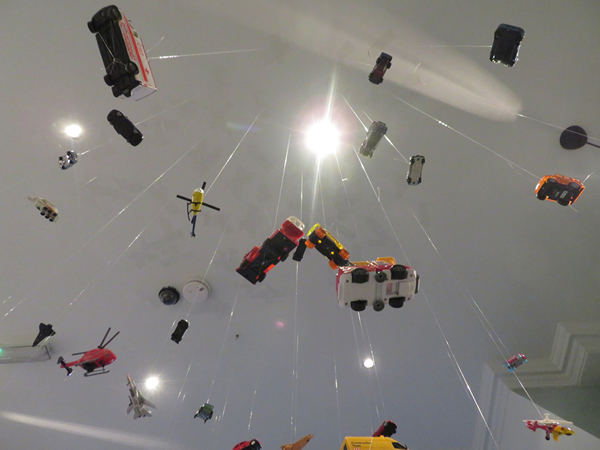
江上越作品《Dialogue beyond 400 years》作品局部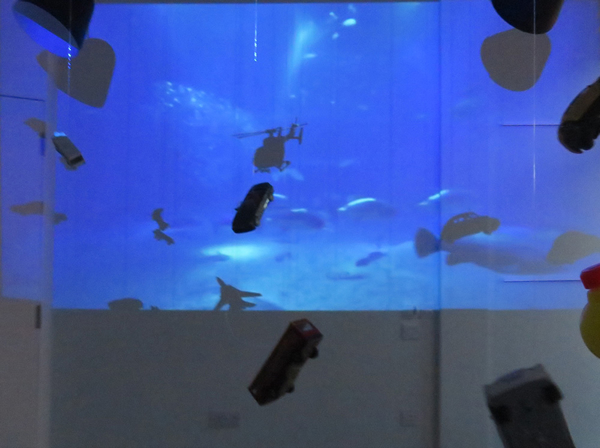
江上越作品《Dialogue beyond 400 years》作品局部-2
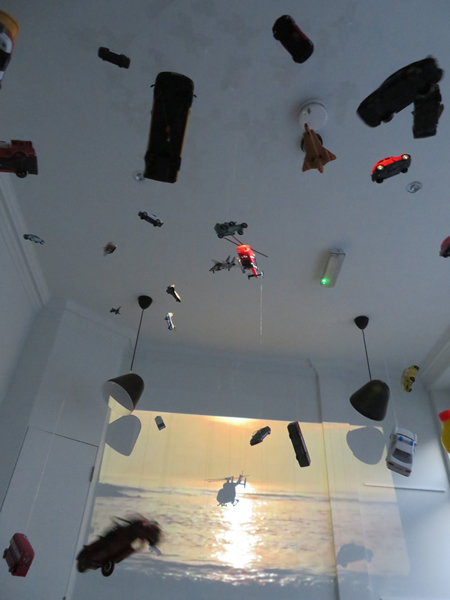
江上越作品《Dialogue beyond 400 years》作品现场-3
江上越
1587年,英军缴获了下加利福尼亚州的西班牙大帆船,并将两名正在船上的日本人加入到他的船上。这两个人成为第一次访问英国的日本人。如果,这个故事是日本和英国交流的开始,
是不是可以说从一开始交流就伴随着偶然和误会。 1600年,英国的威廉·亚当斯(William Adams,1564年-1620年),作为荷兰商船De Liefde号的航海士,因为船漂流到日本海岸,他成为了登陆日本的第一个英国人。被德川幕府重用,后半生他在日本度过,参加了开设在日英国商馆。
日本和英国之间的交流从开始到现在大约400余年。经过四百多年的悠久历史,回首过去,克服了许多艰辛,得到了发展。其中,有许多结果和初愿不同的事实,有偶然和误会,也有交流障碍中的误听误解。固有观念中误听误解往往是负面的,其实有的时侯也是导致进化的正面能量。这也是我创作的着眼点。
日本从英国进口了军舰,蒸汽机,交通设施等,现在也出口高性能电子产品,汽车,高科技等。在西方艺术影响日本的同时,浮世绘和流行的日本可爱文化在英国也很受欢迎。从枪炮外交开始,走向经济文化交流。这些转机和错位的结果意味深长。
我的作品以误听游戏为切入口,验证交流的障碍和可能性。以日英两国交流的史料和大海的映像为背景,在轻松诙谐的气氛中体验航海时代的风云变幻和阴差阳错。提示时代变迁背后人类交流的另一个侧面。"误听"感觉上是很偶然很个人的,但会不会是一种人类的遗产基因呢?我这次的作品是试图将"误听"扩大延展,扩大到国家和地域的交流,延展到民族和文化的碰撞。
Etsu Egami
In 1587 the British seized the Spain galleon ship off Baja California and added the two Japanese who were on board to his ship. These two people became first Japanese who visited the UK. If this story is the start of exchange between Japan and the UK, communication from the beginning it can be said that accompanied by misunderstandings and accidents. Also in 1600, the British William Adams (1564-1620) was a navigator on the Dutch merchant ship Releafde (De Liefde), but as the ship was drifting in Japan, he became the first UK person landed in Japan. He was trated as important by the Tokugawa Bakufu, he spent his late life in Japan and he also involved in opening up a British Trading Post office in Japan.
About 400 years since the communication between Japan and the UK started. After 400 years of long history, looking back, It have overcome many hardships and have developed. Among them, there are facts that resulted and many initial applications is different, and many of them are thought to be due to misunderstanding of communication, misunderstanding and mishearing. Misunderstanding often has negative consequences, but sometimes it leads to evolution. This is also the focus of my creation.
Japan imports warships, steam engines, tracks, etc from the UK, exports high performance electric products, automobiles, technology etc. While Western art influences Japan, Ukiyo-e and popular Japanese Kawaii culture are also popular in the UK. Beginning with gun diplomacy, progress towards economic and cultural exchange. These results of turning points and dislocation seems deeply meaningful.
In my work , Mis-hearing game is the starting point ,to verify the obstacles and the possibility of communication. Based on the historical materials exchanged between Japan and the UK and the images of the sea , we can experience the changing and overblown mistakes in the nautical era in a relaxed and humorous atmosphere. It prompted he other side of human communication behind changes in the times . "Mis-hearing" feels very casual occasionally and personal, but will it be a human genetic heritage? My current work is to try to expand the "Mis-hearing" and extend it to exchanges between countries and regions and extend the collision between ethnic groups and cultures.
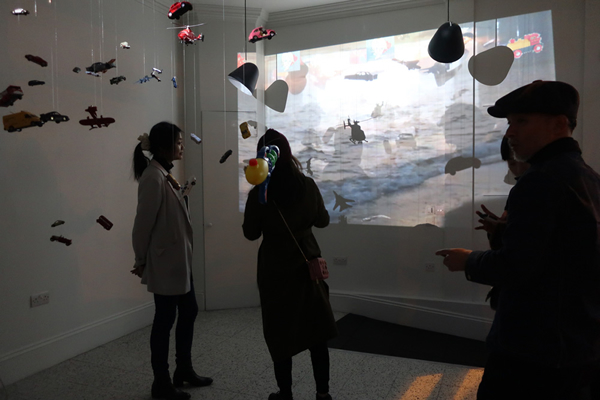
江上越作品《Dialogue beyond 400 years》作品现场-4
To explain Egami Etsus installation in the context of Playground it might be good to write a bit about our concept. Unlike other galleries, Playground is a hybrid between exhibition and studio space, purposefully leaving it's definition - and use - as open as possible. Our main aim is to provide a physical platform for people with talent and initiative, regardless of discipline. The space is to be used in the most suitable way for their "art".
So our role as curator is less making decisions about set up and outcome of the installation but more that of a mentor; giving advice, drafting written concepts, providing visual communication and giving realistic deadlines.
Making culture, language and barriers of communication as a central subject of most of her work, the development of her exhibition idea within our very open concept was an important part of the outcome in my opinion. For us, it was really interesting to see how Egami Etsu developed her idea and the process of adapting it to a relatively restrictive room, both in shape and size.
Overcoming her initial idea of a classic "gallery" and realising she has got a space where she is completely free to play in and create her own exhibition was a great step.
And finally, once set up, having lots of people from different cultures, interests and professions all interacting with each other and reflecting on the installation was great to witness. Needless to say that Egami Etsus artwork seems to be visually very appealing independent of cultural

江上越作品《Dialogue beyond 400 years》作品局部-3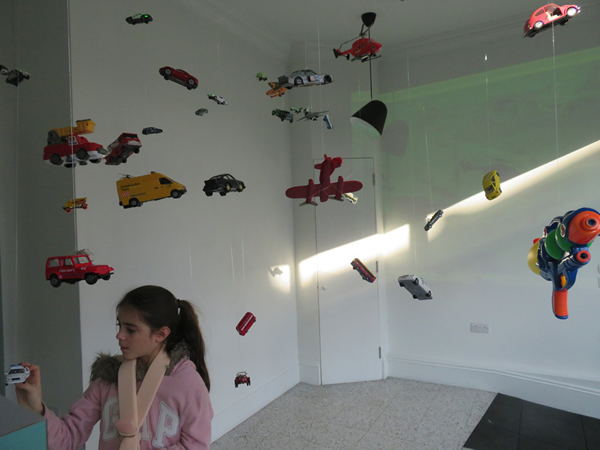
江上越作品《Dialogue beyond 400 years》作品现场--5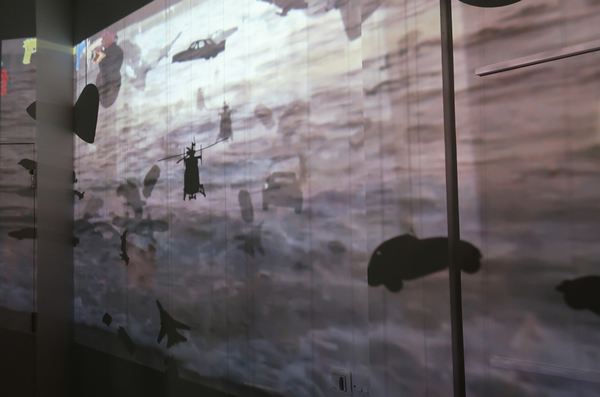
江上越作品《Dialogue beyond 400 years》作品现场-6
艺术家:江上越
学术主持:千叶成夫 (日本重要美术评论家)
近藤成一(东京大学名誉教授,千叶市艺术文化新人奖评委主席)
策展人:Antonia Huber(独立策展人,英国皇家艺术学院老师) Julia von Meiss
开幕:2018.2.23 18:00-
展厅:Playground London Curated place
赞助:日本 SINBY











